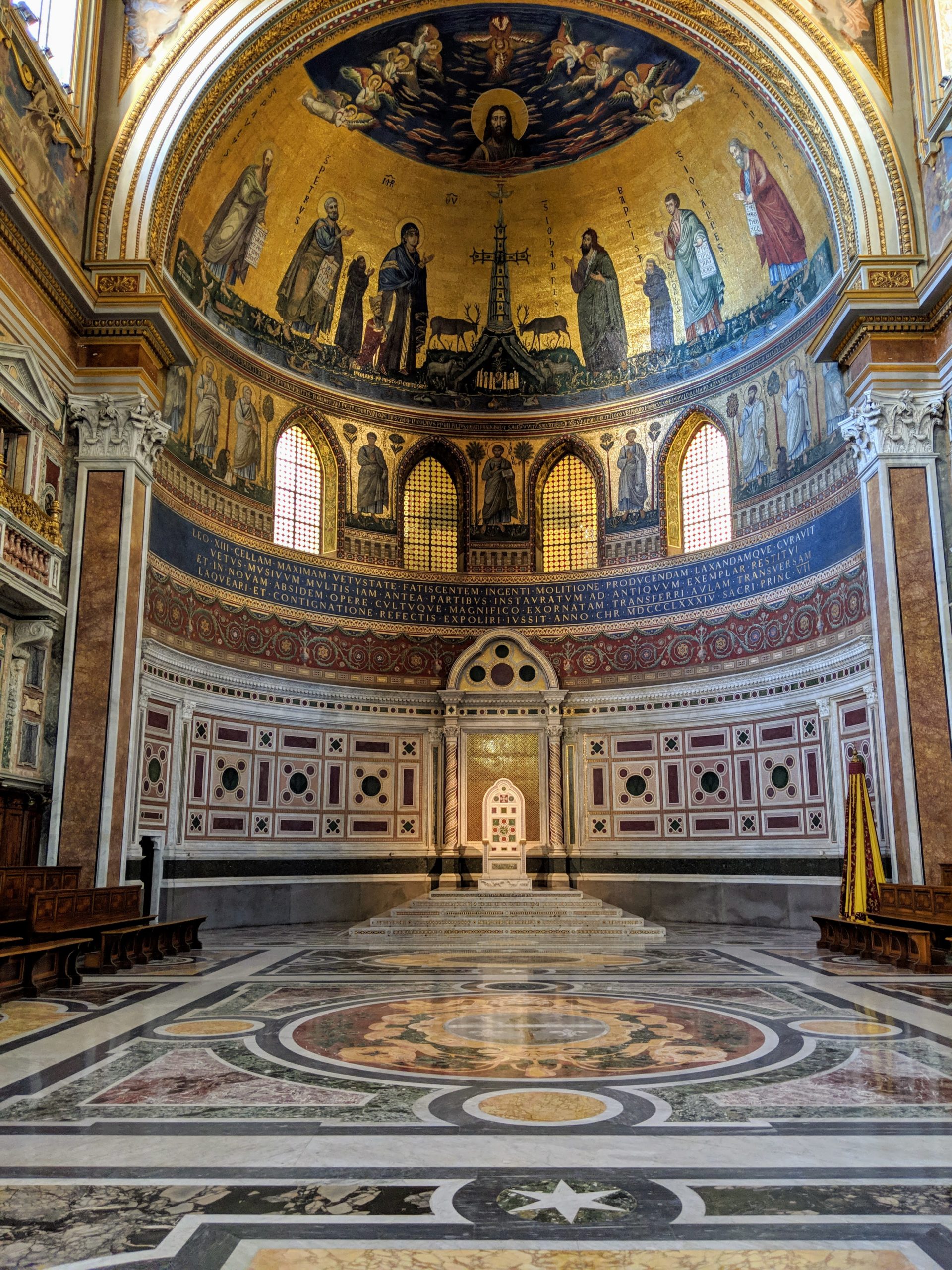
Within the Roman Catholic Church, today is the feast day of the Dedication of the Archbasilica Cathedral of the Most Holy Savior and Saints John the Baptist and John the Evangelist at the Lateran, or far more commonly known, the Dedication of St. John Lateran.
This church is the “mother” church to western Christianity. The first public Christian house of worship in Rome, first dedicated in 324 after Constantine converted and the Roman persecutions ended.
As seen in the picture above, it contains the cathedra for the Bishop of Rome (thus Rome’s cathedral) and the Bishop of Rome is, of course, better known as the Pope.
The cathedra harkens back to the days where a person’s authority was established by their chair—think kings and their thrones. The Church doesn’t believe that the Pope is infallible, but when the Pope speaks ex cathedra, that is “from the chair” and doing so intentionally, he is preserved from making errors.
This was actually only formally defined during Vatican I in the 19th century and there have only been two instances of a Pope speaking ex cathedra to meet this standard: defining the Immaculate Conception (that Mary was born without original sin through the grace of her Son, Jesus) in 1854 and definition the Assumption of Mary, when Pope Pius XII in 1950 said: “By the authority of our Lord Jesus Christ, of the Blessed Apostles Peter and Paul, and by our own authority, we pronounce, declare, and define it to be a divinely revealed dogma: that the Immaculate Mother of God, the ever Virgin Mary, having completed the course of her earthly life, was assumed body and soul into heavenly glory.”
In both of these cases, these beliefs had been held for centuries, but they weren’t dogma officially and formally until then. Historians argue a bit over what other pronouncements in the centuries before would/should/could be considered ex cathedra in the same way.
Anyhow, also the initial sitting in the cathedra is when, technically, a bishop is installed as the bishop. In the case of the Pope and St. John Lateran, while he’s “installed in the Petrine Ministry” in the big Mass at St. Peter’s in the Vatican, he’s installed as the Bishop of Rome at St. John Lateran with a formal “first sitting” (my term!):
That’s why St. John Lateran is treated specially for today. The other papal basilicas also have their dedications on the General Calendar (e.g. the one for the whole church). St. Mary Major, the first church in the world dedicated to Mary, the Mother of God, is celebrated on August 5th. The basilicas of Sts. Peter in the Vatican and Paul Outside The Walls are jointed celebrated on November 18th.
Aside: Yes, this is another instance of Sts. Peter and Paul linked up on the same day. The saints, themselves, are jointed celebrated on June 29th. Their ministries were very opposite in many regards, but they were very complimentary which is a continued lesson still taught today. But, don’t worry, they both have specific feasts relative to them also. The Conversion of St. Paul is remembered on January 25th while The Chair of St. Peter is remembered on February 22nd, honoring the idea of the authority of St. Peter as the first pope. That feast’s name in Latin is Cathedra Petri… Anyhow, back to business.
Why do we care about the dedication of these churches? These churches, in particular, represent four pillars of our church life—the church itself with its evangelization mission, Mary as the Mother of God, and the two Apostles that really spun up the Christian church from the ground up.
Within each parish, the dedication of the parish church is one of the highest-ranked feast days on the proper calendar for that parish—it outranks even Sundays outside of Easter, Lent, or Advent. Within each diocese, the dedication of the cathedral church is a feast day in every parish (though, it doesn’t outrank any Sunday).
The Church is far more than the physical building, but that doesn’t mean the physical buildings aren’t important. They’re the home to Jesus, literally in the Eucharist, and to some of the most sacred moments of our lives. Everything from our baptisms to our weddings to our funerals. They’re the home that generations upon generations of the faithful come to each week to honor and praise God, to gather together to help each other, as a beacon of the faith.
Whether our churches are meager little buildings or the grand ones of Rome, they’re special and sacred. They help us remember that we’re special and sacred too.
As is said in the Office of Readings from the Liturgy of the Hours:
Whenever we come to church, we must prepare our hearts to be as beautiful as we expect this church to be. Do you wish to find this basilica immaculately clean? Then do not soil your soul with the filth of sins. Do you wish this basilica to be full of light? God too wishes that your soul be not in darkness, but that the light of good works shine in us, so that he who dwells in the heavens will be glorified. Just as you enter this church building, so God wishes to enter into your soul, for he promised: I shall live in them, I shall walk through their hearts.
St. Caesarius of Arles as found in the Office of Readings.
St. John Lateran is a beautiful and historical church that, if you ever find yourself in Rome, is home to a lovely little museum and a far quieter experience than the tourist destination of St. Peter’s. It is one of my favorites—may be why I keep writing about its dedication feast day.

Leave a Reply